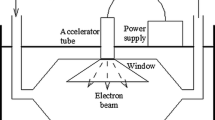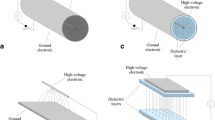Abstract
Several regulations on exhaust gases have been introduced to curb hazardous exhaust of volatile organic compounds (VOCs) and particulate matter (PM) from the paint and printing industries. VOCs produce photochemical oxidants and suspended PM such as PM2.5, which is now recognized as a global environmental problem. We assess a nonthermal plasma technique for controlling VOC emissions, especially, propose a wet-type packed-bed plasma reactor to extend the treatment of water-non-soluble VOCs. This paper proposes a wet-type packed-bed plasma reactor to extend the treatment of water-non-soluble VOCs. The proposed technique is evaluated through the simultaneous removal of nanoparticles and toluene at a relatively high flow rate. Simultaneous treatment of the VOCs and nanoparticles using the reactor indicates that the average particle collection efficiency is 94%, and the removal efficiency of 60 ppm toluene is 73% with a gas flow rate of 10 L/min. The resultant byproducts are benzaldehyde (C6H5CHO), benzyl alcohol (C6H5CH2OH), phenol (C6H5OH), ozone, formic acid, and acetic acid, and some are easily dissolved and removed by the sodium hydroxide solution film. A smaller pellet diameter leads to more efficient toluene removal at lower specific energy values, while the ozone concentration does not change. However, the ozone concentration can be greatly suppressed by dissolving the ozone in the alkali solution film.










Similar content being viewed by others
Availability of Data and Materials
The data and materials that support the findings of this study are available from the corresponding author upon reasonable request.
References
Yamasaki H, Kishimoto K, Shimada T, Kuroki T, Kang J, Kim DW, Yagi T, Okubo M (2022) Toward ideal VOCs and nanoparticle emission control technology using a wet-type catalysis nonthermal plasma reactor. IEEE Trans Ind Appl 58:6591–6598
Shayegan Z, Haghighat F, Lee CS (2019) Photocatalytic oxidation of volatile organic compounds for indoor environment applications: three different scaled setups. Chem Eng J 357:533–546
Liotta LF (2010) Catalytic oxidation of volatile organic compounds on supported noble metals. Appl Catal B 100:403–412
Xin Y, Ando Y, Nakagawa S, Nishikawa H, Shirai T (2020) New possibility of hydroxyapatites as noble-metal-free catalysts towards complete decomposition of volatile organic compounds. Catal Sci Technol 10:5453–5459
Zhang X, Gao B, Creamer AE, Cao C, Li Y (2017) Adsorption of VOCs onto engineered carbon materials: a review. J Hazard Mater 338:102–123
Cheng Y, He H, Yang C, Zeng G, Li X, Chen H, Yu GL (2016) Challenges and solutions for biofiltration of hydrophobic volatile organic compounds. Biotechnol Adv 34:1091–1102
Urashima K, Chang JS (2000) Removal of volatile organic compounds from air streams and industrial flue gases by non-thermal plasma technology. IEEE Trans Dielectr Electr Insul 7:602–610
Kohno H, Berezin AA, Chang JS, Tamura M, Yamamoto T, Shibuya A, Hondo S (1998) Destruction of volatile organic compounds used in a semiconductor industry by a capillary tube discharge reactor. IEEE Trans Ind Appl 34:953–966
Oda T, Takahashi T, Yamaji K (2002) Nonthermal plasma processing for dilute VOCs decomposition. IEEE Trans Ind Appl 38:873–878
Shibata T, Nishiyama H (2014) Acetic acid decomposition in a coaxial dielectric barrier discharge tube with mist flow. Plasma Chem Plasma Process 34:1331–1343
Kuroki T, Nishii S, Kuwahara T, Okubo M (2017) Nanoparticle removal and exhaust gas cleaning using gas-liquid interfacial nonthermal plasma. J Electrostat 87:86–92
Takehana K, Kuroki T, Okubo M (2018) Evaluation on nitrogen oxides and nanoparticle removal and nitrogen monoxide generation using a wet-type nonthermal plasma reactor. J Phys D: Appl Phys 51:204002
Yamasaki H, Nomura S, Xun X, Kuroki T, Kang J, Yagi T, Okubo M (2021) Toward NOx/SOx and nanoparticle control technology using a single-stage wet-type nonthermal plasma reactor. IEEE Trans Plasma Sci 49:1860–1870
Yamamoto T, Ramanathan K, Lawless PA, Ensor DS, Newsome JR, Plaks N, Ramsey H (1992) Control of volatile organic compounds by an ac energized ferroelectric pellet reactor and a pulsed corona reactor. IEEE Trans Ind Appl 28:528–534
Tonkyn RG, Barlow SE, Orlando TM (1996) Destruction of carbon tetrachloride in a dielectric barrier/packed-bed corona reactor. J Appl Phys 80:4877–4886
Feng X, Liu H, He C, Shen Z, Wang T (2018) Synergistic effects and mechanism of a non-thermal plasma catalysis system in volatile organic compounds removal: a review. Catal Sci Technol 8:936–954
Kim HH, Teramoto Y, Negishi N, Ogata A (2015) A multidisciplinary approach to understand the interactions of nonthermal plasma and catalyst: a review. Catal Today 256:13–22
Futamura S, Yamamoto T (1997) Byproduct identification and mechanism determination in plasma chemical decomposition of trichloroethylene. IEEE Trans Ind Appl 33:447–453
Wang B, Chi C, Xu M, Wang C, Meng D (2017) Plasma-catalytic removal of toluene over CeO2–MnOx catalysts in an atmosphere dielectric barrier discharge. Chem Eng Sci 322:679–1692
Yao X, Zhang J, Liang X, Long C (2018) Plasma-catalytic removal of toluene over the supported manganese oxides in DBD reactor: effect of the structure of zeolites support. Chemosphere 208:922–930
Kim HH, Abdelaziz AA, Teramoto Y, Nozaki T, Hensel K, Mok YS, Saud S, Nguyen DB, Lee DH, Kang WS (2021) Interim report of plasma catalysis: footprints in the past and blueprints for the future. Int J Plasma Environ Sci Technol 15:e01004
Ogata A, Shintani N, Yamanouchi K, Mizuno K, Kushiyama S, Yamamoto T (2000) Effect of water vapor on benzene decomposition using a nonthermal-discharge plasma reactor. Plasma Chem Plasma Process 20:453–467
Gunten UV (2003) Ozonation of drinking water: part I. Oxidation kinetics and product formation. Water Res 37:1443–1467
Patil BS, Cherkasov N, Lang J, Ibhadon AO, Hessel V, Wang Q (2016) Low temperature plasma-catalytic NOx synthesis in a packed DBD reactor: effect of support materials and supported active metal oxides. Appl Catal B: Environ 194:123–133
Chen HL, Lee HM, Chen SH, Chang MB (2008) Review of packed-bed plasma reactor for ozone generation and air pollution control. Ind Eng Chem Res 47:2122–2130
Kishimoto K, Kumazawa Y, Kuroki T, Yamasaki H, Okubo M (2020) Ultrasonically enhanced electrohydraulic discharge for removal of organic compounds. J Electrostat 108:103502
Madhukar A, Rajanikanth BS (2019) Cascaded plasma-ozone injection system: a novel approach for controlling total hydrocarbon emission in diesel exhaust. Plasma Chem Plasma Process 39:845–862
Hosseini H, Ghaffarzadeh M (2022) Investigation of plasma induced reactions of liquid toluene in Ar/NH3: the formation of organic compounds through radical intermediates. Chem Lett 51:784–787
Satoh K, Nagao K, Itoh H (2012) Decomposition characteristics of benzene, toluene and xylene in an atmospheric pressure DC corona discharge I. Characteristics of gaseous by-products. Trans Mat Res Soc Jpn 37:151–155
Shoukat H, Altaf AA, Hamayun M, Ullah S, Kausar S, Hamza M, Muhammad S, Badshah A, Rasool N, Imran M (2021) Catalytic oxidation of toluene into benzaldehyde and benzyl alcohol using molybdenum-incorporated manganese oxide nanomaterials. ACS Omega 6:19606–19615
NIST chemical kinetics database. https://kinetics.nist.gov/kinetics/.Accessed 1 May 2023
Mizushima T, Thach TTC, Wen WJ, Ohkita H (2021) Tubular membrane-like catalysts for the oxidative decomposition of low-concentrated toluene in air by periodic short-term plasma discharge. Plasma Chem Plasma Process 41:607–617
Ye Z, Veerapandian SK, Onyshchenko I, Nikiforov A, De Geyter N, Giraudon JM, Lamonier JF, Morent R (2017) An in-depth investigation of toluene decomposition with a glass beads-packed bed dielectric barrier discharge reactor. Ind Eng Chem Res 56:10215–10226
Huang H, Ye D, Leung DYC, Feng F, Guan X (2011) Byproducts and pathways of toluene destruction via plasma-catalysis. J Mol Catal A Chem 336:87–93
Tahara M, Okubo M (2014) Detection of free radicals produced by a pulsed electrohydraulic discharge using electron spin resonance. J Electrostat 72:222–227
National Institute of Standards and Technology. https://webbook.nist.gov/chemistry/form-ser/. Accessed 14 June 2022
The National Institute of Advanced Industrial Science and Technology. https://sdbs.db.aist.go.jp/sdbs/cgi-bin/cre_index.cgi/. Accessed 14 June 2022
Kosaka K (2011) Ozone reactions in water. Chem Educ 59:74–77 (in Japanese)
Yamasaki H, Mizuguchi Y, Nishioka R, Fukuda Y, Kuroki T, Yamamoto H, Okubo M (2022) Pilot-scale NOx and SOx aftertreatment by semi-dry plasma-chemical hybrid process in glass-melting-furnace exhaust gas. Plasma Chem Plasma Process 42:51–71
Acknowledgements
The authors thank Mr. X. Xi and Mr. M. Ohashi, who are graduate students at Osaka Prefecture University, for performing the experiments.
Funding
The work was supported in part by a research collaboration fund of Samsung Advanced Institute of Technology (SAIT) and JSPS KAKENHI Grant Number JP20H02374 and JP23H01626.
Author information
Authors and Affiliations
Contributions
TS, HY, and MO wrote the main manuscript text, and TS and HY prepared all figures. TK, JK, DK, TY, and MO designed the plasma reactor and the experiment. All authors reviewed the measured data and the manuscript.
Corresponding author
Ethics declarations
Conflicts of interest
The authors declare that they have no known competing financial interests or personal relationships that may have appeared to influence the work reported in this paper.
Ethical Approval
Not applicable.
Additional information
Publisher's Note
Springer Nature remains neutral with regard to jurisdictional claims in published maps and institutional affiliations.
Rights and permissions
Springer Nature or its licensor (e.g. a society or other partner) holds exclusive rights to this article under a publishing agreement with the author(s) or other rightsholder(s); author self-archiving of the accepted manuscript version of this article is solely governed by the terms of such publishing agreement and applicable law.
About this article
Cite this article
Shimada, T., Yamasaki, H., Kuroki, T. et al. Wet-Type Packed-Bed Nonthermal Plasma for Simultaneous Removal of PM and VOCs. Plasma Chem Plasma Process 44, 239–255 (2024). https://doi.org/10.1007/s11090-023-10403-1
Received:
Accepted:
Published:
Issue Date:
DOI: https://doi.org/10.1007/s11090-023-10403-1




